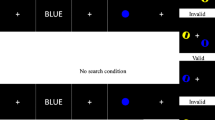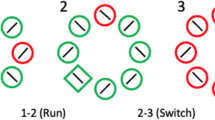Abstract
The three experiments presented in the paper examine visual prior entry (determining which of two stimuli appeared first) and prior exit (determining which of two stimuli disappeared first) effects with a temporal order judgment (TOJ) task. In addition to using onset and offset targets, the preceding cues also consisted of either onset or offset stimuli. Typical, and equivalent, prior entry effects were found when either onset or offset cues preceded the onset targets. Unexpectedly large prior exit effects where found with the offset targets, with offset cues producing greater capture effects than onset cues. These findings are consistent with the notion that more attention is allocated to searching the visual field when targets are more difficult to find. In addition, the results indicate that attentional control settings may be more likely to occur with more difficult searches. In addition, these findings demonstrate that TOJ tasks provide extremely precise measures of the allocation of attention and are very sensitive to a range of task manipulations.





Similar content being viewed by others
References
Bachmann, T., Poder, E., & Luiga, I. (2004). Illusory reversal of temporal order: the bias to report a dimmer stimulus as the first. Vision Research, 44, 241–246.
Bacon, W. F., & Egeth, H. (1994). Overriding stimulus-driven attentional capture. Perception & Psychophysics, 51, 599–606.
Birmingham, E., & Pratt, J. (2005). Examining inhibition of return with onset and offset cues in the multiple cueing paradigm. Acta Psychologica, 118, 101–121.
Boot, W. R., Kramer, A. F., & Peterson, M. S. (2005). Oculomotor consequences of abrupt onsets and offsets: Onsets dominate oculmotor capture. Perception & Psychophysics, 67, 910–928.
Brockmole, J. R., & Henderson, J. M. (2005). Object appearance, disappearance, and attention prioritization in real-world scenes. Psychonomic Bulletin & Review, 12, 1061–1067.
Castel, A., Chasteen, A. L., Scialfa, C. T., & Pratt, J. (2003). Adult age differences in the time course of inhibition of return. Journal of Gerontology: Psychological Sciences, 58, 256–259.
Clifford, C. W. G., Arnold, D. H., & Pearson, J. (2003). A paradox of temporal perception revealed by a stimulus oscillating in colour and orientation. Vision Research, 43, 2245–2253.
Craig, J. C., & Busey, T. A. (2003). The effect of motion on tactile and visual temporal order judgments. Perception & Psychophysics, 65, 81–94.
DiLollo, V., Enns, J. T., Yantis, S., & Dechief, L. G. (2000). Response latencies to the onset and offset of visual stimuli. Perception & Psychophysics, 62, 218–225.
Folk, C. L., Remington, R. W., & Wright, J. H. (1994). The structure of attentional control: contingent attentional capture by apparent motion, abrupt onset, and color. Journal of Experimental Psychology: Human Perception & Performance, 20(2), 317–329.
Frey, R. D. (1990). Selective attention, event perception and the criterion of acceptability principle: evidence supporting and rejecting the doctrine of prior entry. Human Movement Science, 9, 481–530.
Gibson, B. S., & Kelsey, E. M. (1998). Stimulus-driven attentional capture is contingent on attentional set for displaywide visual features. Journal of Experimental Psychology: Human Perception & Performance, 24, 699–706.
Jaskowski, P. (1991). Perceived onset simultaneity of stimuli with unequal durations. Perception, 20, 715–726.
Jaskowski, P. (1993). Selective attention and temporal-order judgment. Perception, 22, 681–689.
Klein, R. M. (2000). Inhibition of return. Trends in Cognitive Sciences, 4, 138–147.
Pratt, J., & McAuliffe, J. (2001). The effects of onsets and offsets on visual attention. Psychological Research, 65, 185–191.
Pratt, J., & Trottier, L. (2005). Pro-saccades and anti-saccades to onset and offset targets. Vision Research, 45, 765–774.
Pratt, J., Theeuwes, J., & Donk, M. (2007). Offsets and prioritizing the selection of new elements in search displays: More evidence for attentional capture in the preview effect. Visual Cognition, 15, 133–148.
Reuter-Lorenz, P. A., Jha, A. P., & Rosenquist, J. N. (1996). What is inhibited in inhibition of return? Journal of Experimental Psychology: Human Perception & Performance, 22, 367–378.
Riggio, L., Bello, A., Umilta, C. (1998). Inhibitory and facilitatory effects of cue onset and offset. Psychological Research, 61, 104–118.
Samuel, W., & Weiner, S. K. (2001). Attentional consequences of object appearance and disappearance. Journal of Experimental Psychology: Human Perception & Performance, 27, 1433–1451.
Schneider, K. A., & Bavelier, D. (2003). Components of visual prior entry. Cognitive Psychology, 47, 333–366.
Shore, D. I., Spence, C., & Klein, R. M. (2001). Visual prior entry. Psychological Science, 12, 205–212.
Stelmach, L. B., & Herdman, C. M. (1991). Directed attention and perception of temporal order. Journal of Experimental Psychology, 17, 539–550.
Ulrich, R. (1987). Threshold models of temporal-order judgments evaluated by a ternary response task. Perception & Psychophysics, 42, 224–239.
Acknowledgements
This research was funded by NSERC grants to S. Ferber and J. Pratt. Correspondence regarding this paper should be addressed to: Jay Pratt, Department of Psychology, University of Toronto, 100 St. George Street, Toronto, Ontario, Canada M5S 3G3.
Author information
Authors and Affiliations
Corresponding author
Rights and permissions
About this article
Cite this article
Vingilis-Jaremko, L., Ferber, S. & Pratt, J. Better late than never: how onsets and offsets influence prior entry and exit. Psychological Research 72, 443–450 (2008). https://doi.org/10.1007/s00426-007-0120-8
Received:
Accepted:
Published:
Issue Date:
DOI: https://doi.org/10.1007/s00426-007-0120-8




